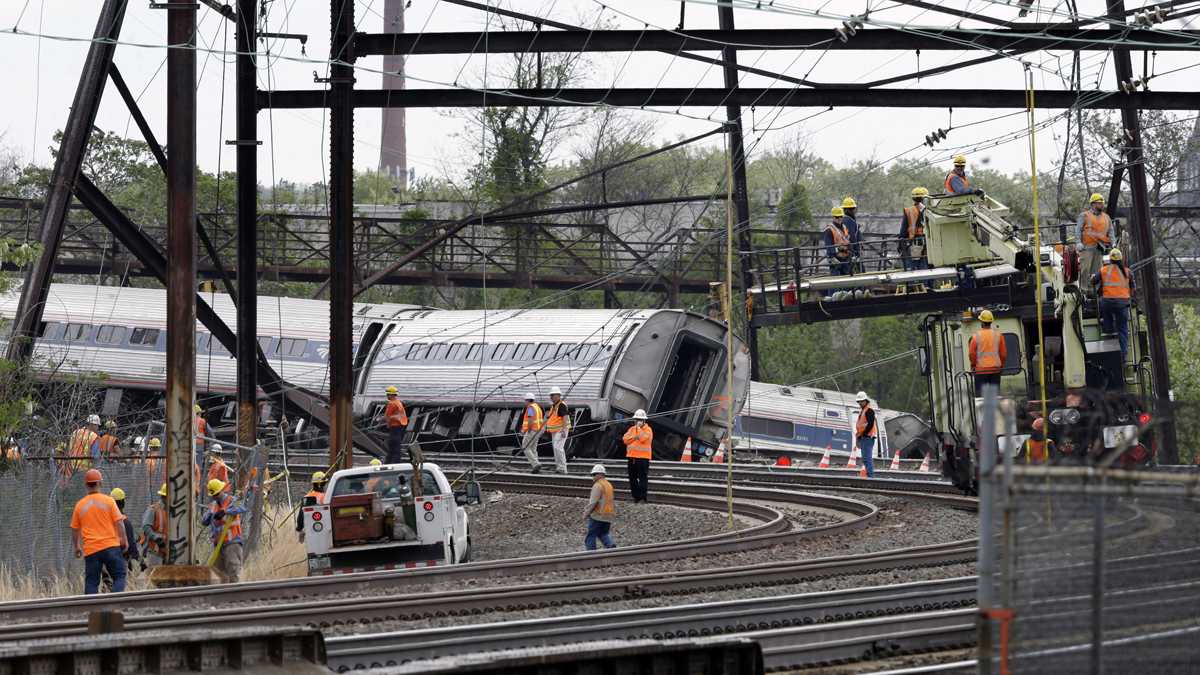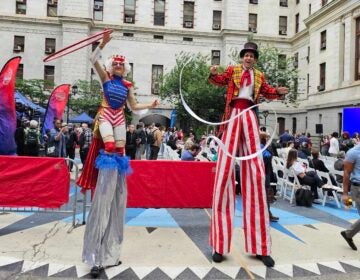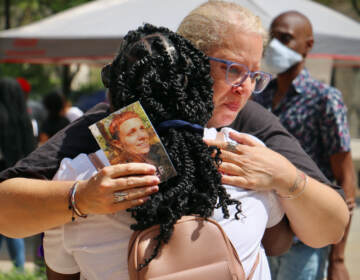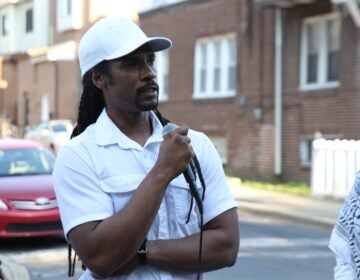Amtrak engineer in fatal crash remembers more details, lawyers fault ‘changing story’

Emergency personnel walk near the scene of a deadly train wreck, Wednesday, May 13, 2015, in Philadelphia. (Mel Evans/AP Photo)
The engineer of the Amtrak train that derailed in Philadelphia last May, killing eight, told investigators he has very little memory of the crash.
The engineer’s comments are part of a trove of documents released Monday by the National Transportation Safety Board, the federal agency investigating the derailment. Excessive speed caused the train to derail; however, the more than 2,000 pages of evidence offer no official explanation for why the train was going twice the speed limit when it entered a curve at Frankford Junction in Philadelphia’s Port Richmond neighborhood on the night of May 12, 2015.
‘This is it. I’m going over’
While an NTSB official who spoke to members of the press on condition of anonymity said the documents reveal “no smoking guns,” it is the first time the public is hearing from Brandon Bostian, Amtrak 188’s locomotive engineer who has declined to speak to the media.
Investigators interviewed Bostian twice: once on May 15, three days after the accident, and again on Nov. 10.
“Unfortunately, the last memory I have on the way back is approaching and passing the platforms in North Philadephia,” Bostian said during an interview at 30th Street Station on May 15, according to the transcripts released Monday. “I remember turning on the bell, and the next thing that I remember is when I came to my senses I was standing up in the locomotive cab after the accident.”
Bostian told investigators he was suffering from a head injury sustained in the incident — he received several stitches in his forehead and said he had been diagnosed with a concussion. Before the accident, he said he was in good health, not taking any medications and had been sleeping well at night.
“I mean, you look like you’re really, like you’re hurting,” Dr. Mary Pat McKay, the NTSB’s chief medical officer, said to Bostian during the first interview.
He also remembered taking his cellphone out of his backpack, turning it on, turning off “airplane mode” and lending it to a passenger. During the second interview, he told investigators he was “always paranoid about getting caught with my cellphone on.” Other evidence released by the NTSB confirmed Bostian had not used his cellphone during the time of the accident.
Six months later, Bostian said two “prominent scenes” had come back to him. The first was while Bostian was coming out of a 65 mile per hour curve into an 80 mile per hour straightaway on his way out of Philadelphia. Bostian remembered decelerating to 70 miles per hour, ten miles under the speed limit, “by mistake.” Then, realizing his error, he pushed the throttle forward to accelerate to 80 miles per hour. From there, his memory fades until he vaguely sensed he was in the curve and felt the train accelerating faster. Bostian hit the emergency brake, but it was too late. The train sped through the 50 mile per hour curve at 106 miles per hour.
“I remember holding onto the controls tightly and feeling like, OK well this is it. I’m going over,” he said.
The NTSB official described Bostian as “extremely cooperative” and said the board would release the probable cause of the accident, as well as safety recommendations sometime this spring.
Victims’ lawyers point to engineer’s ‘changing story’
Lawyers representing some of those injured or killed in the crash and their families said Monday the evidence released points the finger squarely at Bostian.
“The problem remains his changing story, which started with ‘I have no recollection whatosever’ and now becomes ‘I have memory of what occurred, but I mysteriously have a gap as well,'” said Philadelphia attorney Robert Mongeluzzi whose firm represents 17 of the passengers who filed claims.
Amtrak has admitted fault for the crash, so the legal question is how much money victims and their families will receive as federal law caps payouts in Amtrak crashes at $295 million. More than 60 damages cases related to the accident have been consolidated under one federal judge in Philadelphia.
‘Your reaction is to flinch, to duck’
Railroad safety consultant Richard Beall also believes the blame will utimately fall on Bostian, although he does not believe it will be deserved.
He points to the fact that the train’s assistant conductor, Akida Henry told investigators she heard Bostian say the train had been hit by something several minutes before the crash — she could not say whether it was “maybe four or five” or ten.
“I’m not sure about the minutes, but shortly after we left Philadelphia, Brandon got on the radio and said to CTEC, ‘I don’t know if somebody is shooting at us or if they’re throwing rocks, but I see it,'” said Henry.
Beall, who was a locomotive engineer for 40 years, believes that’s the key to figuring out what happened.
“I can tell you by firsthand experience when something hits you out of the clear blue…, it sounds like a cannon going off,” he said. “It sounds like a possible gunshot and your reaction is to flinch, to duck and there’s a very good possibility this man hit his head.”
Among the evidence released Monday was an email from the FBI, which examined a window from an Acela train heading southbound to Washington, D.C. that same night and had been damaged in about the same time and place as Amtrak 188. The FBI found there was no evidence that train’s window had been hit by a bullet, but that did not rule out the possibility of a rock, an NTSB spokesman said.
During the first interview on May 15, Bostian told investigators he passed a SEPTA train that had also been hit by something just before the 188 crash, which made him “concerned.”
An investigator asked Bostian if he was concerned for his own safety.
“Slightly, but I figured there’s a good chance that they left,” he said. “Whoever was throwing rocks and shooting probably had left. I wasn’t, you know, super concerned, I don’t think.”
Bostian said he doesn’t remember any rocks hitting the train.
WHYY is your source for fact-based, in-depth journalism and information. As a nonprofit organization, we rely on financial support from readers like you. Please give today.




